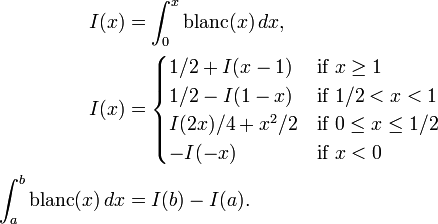Blancmange curve

In mathematics, the blancmange curve is a fractal curve constructible by midpoint subdivision. It is also known as the Takagi curve, after Teiji Takagi who described it in 1903, or as the Takagi–Landsberg curve, a generalization of the curve named after Takagi and Georg Landsberg. The name blancmange comes from its resemblance to a pudding of the same name. It is a special case of the more general de Rham curve.
Definition
The blancmange function is defined on the unit interval by
where  is defined by
is defined by  ,
that is,
,
that is,  is the distance from x to the nearest integer.
is the distance from x to the nearest integer.
The Takagi–Landsberg curve is a slight generalization, given by
for a parameter w; thus the blancmange curve is the case  . The value
. The value  is known as the Hurst parameter.
is known as the Hurst parameter.
The function can be extended to all of the real line: applying the definition given above shows that the function repeats on each unit interval.
Properties
Convergence and continuity
The infinite sum defining  converges absolutely for all x: since
converges absolutely for all x: since  for all
for all  , we have:
, we have:
-
 if
if  .
.
Therefore, the Takagi curve of parameter w is defined on the unit interval (or  ) if
) if  .
.
The Takagi function of parameter w is continuous. Indeed, the functions  defined by the partial sums
defined by the partial sums  are continuous and converge uniformly toward
are continuous and converge uniformly toward  , since:
, since:
-
 for all x when
for all x when  .
.
This value can be made as small as we want by selecting a big enough value of n. Therefore, by the uniform limit theorem,  is continuous if |w|<1.
is continuous if |w|<1.
The special case of the parabola
For  , one obtains the parabola: the construction of the parabola by midpoint subdivision was described by Archimedes.
, one obtains the parabola: the construction of the parabola by midpoint subdivision was described by Archimedes.
Differentiability
The Takagi curve is a fractal for parameters  , as it is nowhere differentiable.
, as it is nowhere differentiable.
Graphical construction
The blancmange curve can be visually built up out of triangle wave functions if the infinite sum is approximated by finite sums of the first few terms. In the illustration below, progressively finer triangle functions (shown in red) are added to the curve at each stage.
 |  |  |  |
| n = 0 | n ≤ 1 | n ≤ 2 | n ≤ 3 |
Recursive Definition
The periodic version of the Takagi curve can also be defined recursively by:
-
 .
.
The version restricted to the unit interval can also be defined recursively by:
Proof:
-
 .
.
Other Properties
Integrating the Blancmange curve
Given that the integral of  from 0 to 1 is 1/2, the identity
from 0 to 1 is 1/2, the identity  allows the integral over any interval to be computed by the following relation. The computation is recursive with computing time on the order of log of the accuracy required.
allows the integral over any interval to be computed by the following relation. The computation is recursive with computing time on the order of log of the accuracy required.
Relation to simplicial complexes
Let
Define the Kruskal–Katona function
The Kruskal–Katona theorem states that this is the minimum number of (t − 1)-simplexes that are faces of a set of N t-simplexes.
As t and N approach infinity,
 (suitably normalized) approaches the blancmange curve.
(suitably normalized) approaches the blancmange curve.
See also
References
- Weisstein, Eric W., "Blancmange Function", MathWorld.
- Teiji Takagi, "A Simple Example of a Continuous Function without Derivative", Proc. Phys. Math. Japan, (1903) Vol. 1, pp. 176–177.
- Benoit Mandelbrot, "Fractal Landscapes without creases and with rivers", appearing in The Science of Fractal Images, ed. Heinz-Otto Peitgen, Dietmar Saupe; Springer-Verlag (1988) pp 243–260.
- Linas Vepstas, Symmetries of Period-Doubling Maps, (2004)
- Donald Knuth, The Art of Computer Programming, volume 4a. Combinatorial algorithms, part 1. ISBN 0-201-03804-8. See pages 372-375.
Further reading
- Allaart, Pieter C.; Kawamura, Kiko (11 October 2011), The Takagi function: a survey, arXiv:1110.1691
- Lagarias, Jeffrey C. (17 December 2011), The Takagi Function and Its Properties, arXiv:1112.4205





